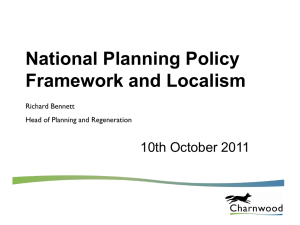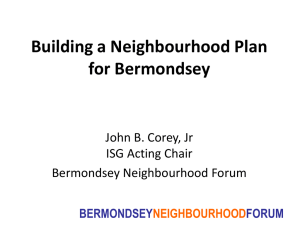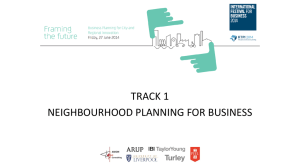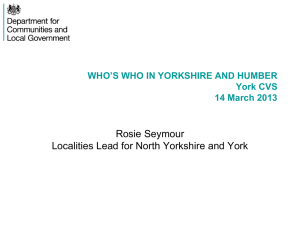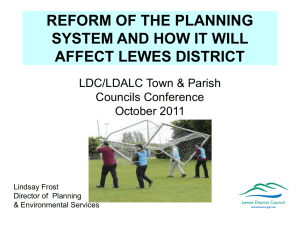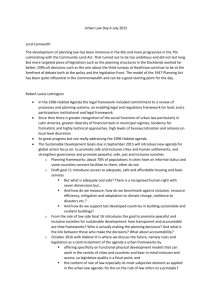Neighbourhood planning
advertisement
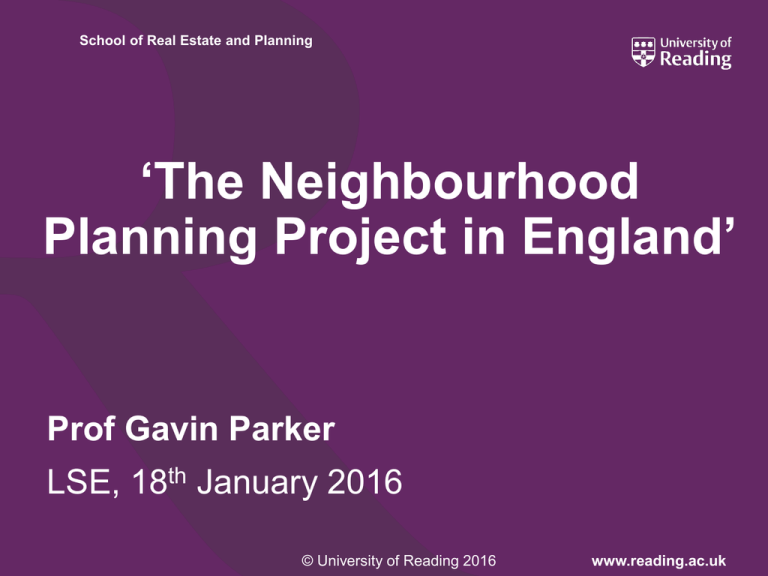
School of Real Estate and Planning ‘The Neighbourhood Planning Project in England’ Prof Gavin Parker LSE, 18th January 2016 © University of Reading 2016 www.reading.ac.uk • Presentation based on: Parker, G. (2015) ‘The Take-up of Neighbourhood Planning in England 2011-2015’. Working Papers in Real Estate & Planning #06/15. University of Reading, Reading. pp21. http://centaur.reading.ac.uk/43545/7/wp0615.pdf Neighbourhood Planning • Involved directly in orchestration of NP between 20122014 via RTPI/Planning Aid England • NP ‘User experience’ published October 2014 • Many issues identified in this & wider lit: – – – – – – – Speed / delay Role of LPA Advice / guidance Scope Weight / relationship with the Local Plan ‘Ownership’ Non-participation • NP as a microcosm of planning issues generally… • Neighbourhood Planning – Localism Act 2011 • Part of a wider shift in planning: – – – – Growth Decentralisation Hybridity and Fuzziness Market / private sector role Foucaultian perspective on neo-liberalisation of Planning inc. Technologies of: – Agency and – Performance »» contestation at and across scale • NP offers Bounded autonomy - circumscribed space • An ‘invited space’ of participation (Gaventa, 2004) • Neighbourhood plans must be in ‘general conformity’ with the NPPF and the strategic policies of the Local Plan as prepared by the local planning authority (DCLG, 2012: para. 184) • Neighbourhood Development Plans and growth: ‘that [NPs] support the strategic development needs set out in Local Plans, including policies for housing and economic development’ (NPPF, 2012: para 16) and that: ‘Neighbourhood Plans and Orders should not promote less development than set out in the Local Plan or undermine its strategic policies’ (NPPF, 2012: para 184). ‘In the context of neighbourhood planning, the agency of individuals is mobilised by the construction of a new identity as a member of neighbourhood forum. Their capacity is then redeployed to achieve government’s objectives which are currently centred on increasing the rate of house building and development in general’ (Davoudi & Madanipour, 2013: p555) • Localism Act 2011 has created a distinct spatial arrangement for the exercise of government – the neighbourhood: ‘Its manifestation in planning is the assumption that our capacities can be best utilised if we engage in neighbourhood, rather…city or regional or national planning’ (Davoudi & Madanipour, 2013: p558) • Localism under the Coalition / Conservative party ‘It brings geographical understandings about scale and place together with sets of political understandings about decentralisation, participation, and community, and managerialist understandings about efficiency and forms of market delivery... It is often intentionally associated, confused, or conflated with local government, local democracy, community, decentralisation, governance, privatisation, civil society etc. for political effect’ (Clarke and Cochrane, 2013: p14-15). • ‘Typically’ +2 years • What is involved in NP (and Who?) Steps – – – – – – – – Area Forum (the qualifying body) Area Designation / Parish or combined Evidence gathering / Consultation / Engagement Draft plan Pre-submission Consultation Submission Independent examination (and report) Referendum • Who is involved? • NP as co-produced enterprise? • At least 70% of NDPs involve private planning consultants (Parker et al, 2014; 2015) • LPA – ‘Duty to support’ • Gatekeeper role • Mixed levels of support… • Lowndes and Pratchett (2012) - communities will benefit or respond differently and in an uneven way to the government’s localism agenda, • Neighbourhoods ‘sinking or swimming on the tides of localism’. • Experience of participatory opportunities in the past known variation in capacity across localities. • Way that NP has been designed / framed…(Gunn et al 2015; Parker et al, 2015) Who is participating and where? Take-up and Progress of Neighbourhood Planning Areas (Aug 2015) NP Activity NP referendum Spring 2013 Spring 2014 Spring 2015 Summer 2015 DCLG Forecast take-up 762 1143 1524 n/a Actual NP take-up 511 1000 1400 1500 (Source: based on DCLG, 2012a and successive ‘NP notes’ produced by DCLG) NB. by January 2015 - 107 to referendum 1 8 60 80 Region / Qualifying Body (Parish/Forum) Distribution of Neighbourhood Planning (Aug 2015) NP to referendum: Parish / Forum / Total NP Qualifying Bodies*: Parish / Forum / Total 0 / 2 = (2) 7 / 68 = (75) South East 34 / 2 = (36) 299 / 15 = (314) South West 9 / 0 = (9) 274 / 7 = (281) West Midlands 9 / 1 = (10) 213 / 5 = (218) East Midlands 8 / 0 = (8) 167 / 7 = (174) East of England 7 / 0 = (7) 165 / 1 = (166) Yorks & Humber 1 / 0 = (1) 84 / 8 = (92) North West 6 / 0 (6) 83 / 22 = (105) North East 1 / 0 (1) 41 / 4 = (45) 75 / 5 = (80) 1333 / 137 = (1470) Region (England) London England (total) Index of Multiple Deprivation breakdown of NP Qualifying Bodies Region / Pop. (England) IMD IMD IMD IMD IMD Q1 Q2 Q3 Q4 Q5 London (8.174m) South East (8.635m) South West (5.289m) West Midlands (5.602m) East Midlands (4.533m) East of England (5.847m) Yorks & Humber (5.284m) North West (7.052m) North East (2.597) All 0 1 5 55 14 75 67 165 67 15 0 314 0 81 125 75 0 281 0 77 129 7 5 218 24 70 50 29 1 174 24 74 53 15 0 166 0 22 8 60 2 92 0 35 42 22 6 105 0 0 14 30 1 45 115 525 493 308 29 1470 (7.8%) (35.7%) (33.5%) (20.9%) (2%) (100%) (53.013m) Totals Note: based on 2011 IMD classifications and 2011 Census. Q1 = least deprived / Q5 = most deprived. Experiences • • • • • • • Burdensome Support Needed help Guidance too vague Critical of scope and control Contestation over scope and resistance to the ‘technologies’ Depends where you are, what other plans are in place, what type of LA you have • Not necessarily a tool for all – need to ensure that alternatives are visible and supported • Objective –led i.e. The right tool and support for the task / substantive issues faced… Conclusions • Particular type of take-up – a mixed game • Predominately rural – inertias and gains for QBs • Slow progress – burdensome • Some areas have adopted NP as a mainstream approach to local planning • e.g. Herefordshire, Sussex, Leeds References • Bradley, Q. (2015) ‘The political identities of neighbourhood planning in England’, Space and Polity, Vol. 19(2): 97-109. • Clarke, N. and Cochrane, A. (2013) ‘Geographies and politics of localism: the localism of the United Kingdom’s Coalition government’, Political Geography, Vol. 34(1): 10-23. • Davoudi, S. and Madanipour, A. (2013) ‘Localism and Neo-liberal Governmentality’, Town Planning Review, Vol. 84(5): 551-562. • Gaventa, J. (2004) ‘Towards participatory governance: assessing the transformative possibilities’ pp25-41, in Hickey, S. and Mohan, G. (eds.) Participation: from tyranny to transformation? Zed Books, London. • Gunn, S., Brooks, E., and Vigar, G. (2015) ‘The Community’s Capacity to Plan: the disproportionate requirements of the new English Neighbourhood Planning initiative’ pp147167 in Davoudi, S. and Madanipour, A. (eds.) Reconsidering Localism. Routledge, London. • Lowndes, V. and Pratchett, L. (2012) ‘Local governance under the Coalition Government: Austerity, Localism and the ‘Big Society’, Local Government Studies, Vol. 38(1): 21-40. • Parker, G. (forthcoming) ‘The Uneven Geographies of Planning in England’, in Bradley, Q. and Brownill, S. (eds.) Neighbourhood Planning and Localism: Power to the People? Policy press, Bristol. • Parker, G., Lynn, T. and Wargent, M. (2015) ‘Sticking to the script? The co-production of Neighbourhood Plans’, Town Planning Review, Vol. 86(5): 519-536. • Parker, G., Lynn, T., Wargent, M. and Locality (2014) User Experience of Neighbourhood Planning in England. Published report. October 2014. Locality, London. • Questions…
